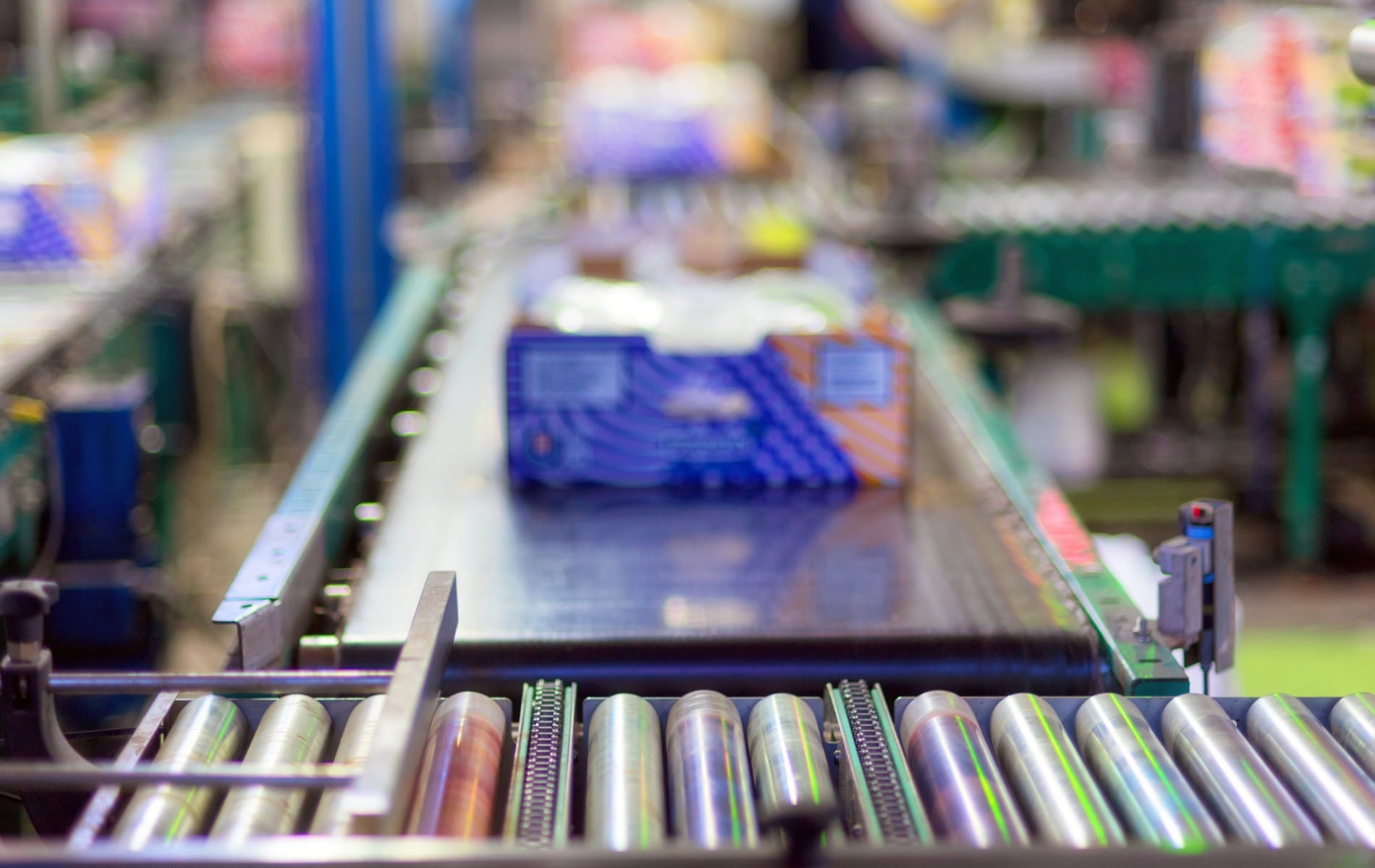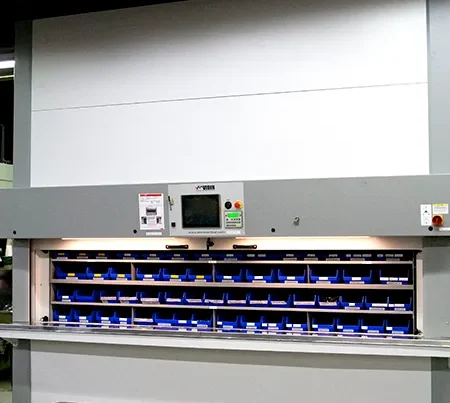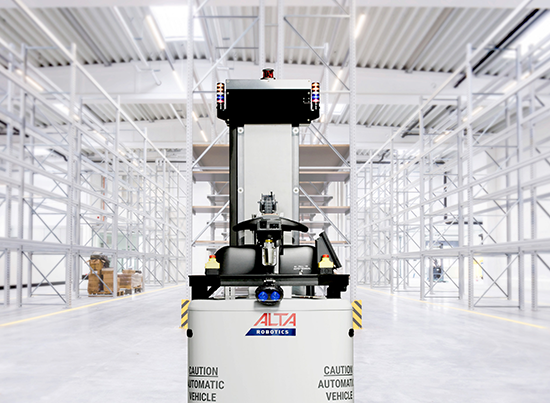Conveyors can be found everywhere in our society. They feed the silos that hold the grain that helps feed the world. They grease the wheels of commerce and tourism by moving luggage through airports. And of course they are the arteries of e-commerce, moving through warehouses the thousands of items each hour that online shoppers expect to be out the door – and possibly at their door – that same day.
Conveyors are ubiquitous in our society for very good reasons. They are reliable, safe, and energy efficient.
In order fulfilment in particular, conveyors increase throughput and decrease costs. As much as 60% of an average warehouse’s operational budget is in the picking process. Much of that is spent on paying operators to travel to the pick face. By bringing goods to an operator using conveyors and sorters, you not only decrease those costs, but can increase safety by reducing forklift traffic and delivering product to the operator at an ergonomic height.
At PeakLogix, we understand the need that every organization is facing to stay competitive in a global market. Our mission is to help you reduce costs, increase throughput, and gain efficiencies through the intelligent integration of automation and other services.
We know firsthand how data and technology have increased the number of available options exponentially. To help you better understand those options, and some of the industry jargon behind them, we’ve created this primer on conveyors.
Our goal here is to provide you with information on your options. For most of these systems, we have a proven record of system integration with quantifiable results. Should your needs fall outside of our standard integrations, we would nevertheless be happy to hear from you, and help get you started in your selection process.
Types of conveyors
Conveyors fall into two main categories – powered and unpowered. Powered conveyors use a motor to move loads, possibly by driving a belt, pulling a chain, or vibrating a bed. Unpowered conveyors often rely on gravity to move their loads – the rate of flow can be adjusted in the design process by increasing or decreasing the declination of the conveyor. Of course, items can also be moved across unpowered conveyors manually.
Belt conveyor
Belt conveyors are a simple, versatile, and efficient means of transporting boxes, totes, or other packaged goods, and also bulk materials such as grain, ore, gravel, or sand.
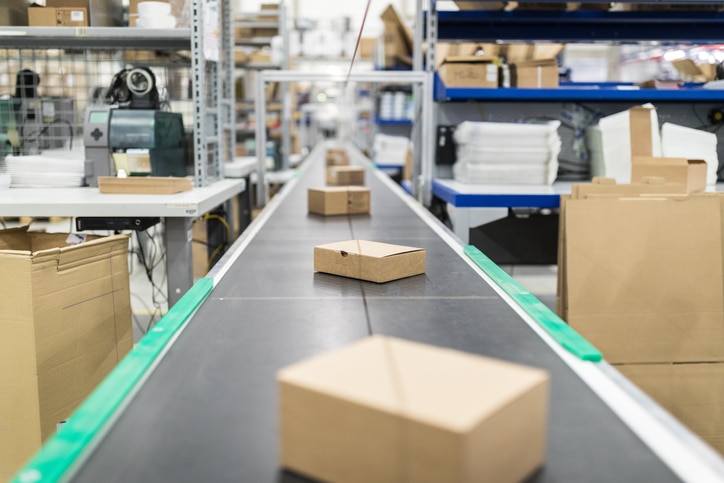
The “endless loop” of the belt is wrapped around pulleys (aka drums or rollers). Drive pulleys are powered; idler pulleys are not. Because the belt is under continuous stress and may stretch, the system may also include tensioner, bend, and take-up pulleys.
Probably the most familiar belt conveyor is the flat belt conveyor, similar to those used at grocery checkouts. That is not, however, the only kind of belt conveyor. Troughed belt conveyors can be used for bulk material and, at higher capacities and speeds, are excellent alternatives to flat belts.
Elevator belts are equipped with regularly spaced partitions or platforms. These can be used to move material between levels of a building.
Gravity roller conveyor
Gravity roller conveyors are made up of a series of rollers mounted on axles connected to a frame. The rollers are allowed to spin freely by ball bearings placed between them and their axles.
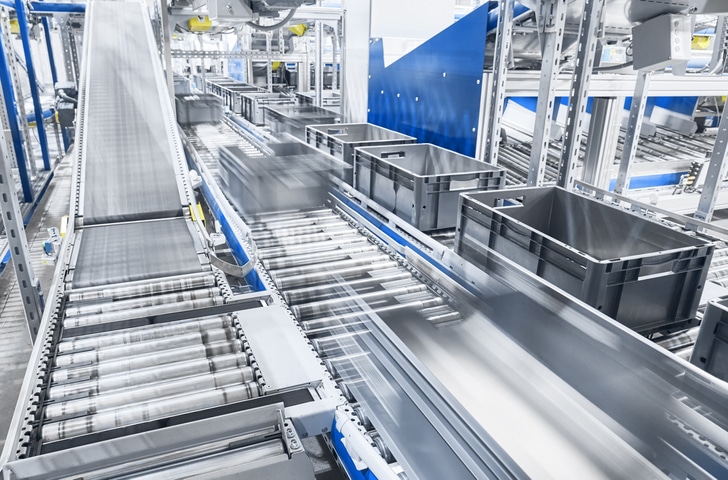
Loads across non-powered rollers are easily moved by operators, or the frame can be installed at a decline to allow gravity to do the work.
Powered roller conveyor
Powered rollers look much like their non-powered cousins. In a powered roller conveyor, however, at least some of the rollers are powered to propel loads. Rollers can be powered by a belt running beneath the rollers called a lineshaft. Or, rollers can be individually powered by motors. A common set-up of this system powers every ninth roller, though it could be more.
An advantage to powered rollers is that each roller can be controlled by a driver, which adds control and flexibility to the system. Product can be stopped, started, slowed, or accumulated at various points in the process. This allows for a great deal of control in the flow of the product, and can prevent bottlenecks and maximize labor up and down the line.
Slat/apron conveyors
Superficially, slat and apron conveyors look to function much like belt conveyors. Instead of having a pliable rubber belt, however, slat and apron conveyors have slats, plates, or trays.
Slat conveyors are often used in assembly lines for packed products or to move heavy or abrasive materials such as metal or brick. Fixtures that secure parts can be attached to strategically spaced slats, so that pieces can be moved more safely down a line. In material handling more generally, slat conveyors are also used to move items that belts and rollers could not, either because of sharp edges, weight, or condition.
Apron conveyors are, in general, similar to slat conveyors, except that their slats overlap to provide a continuous, leak-proof surface. They can have a degree of freedom that allows their beds to handle turns, but are robust enough to handle impacts from, for example, loads dropped from a chute.
Slat and apron conveyors are often chain driven, but may also be driven by powered rollers. In this case, the rollers have teeth that hook into the underside of the plates.
Ball transfer conveyor
Ball transfer tables are frequently seen at points in a conveyor system where loads need to change direction, such as the beginning and ending of a line, or when two lines merge. Because the 360° of rotation they offer facilitates handling, they are also used at work and packing stations.
There are many styles of ball transfers. All of them look like a table of either steel or nylon balls.
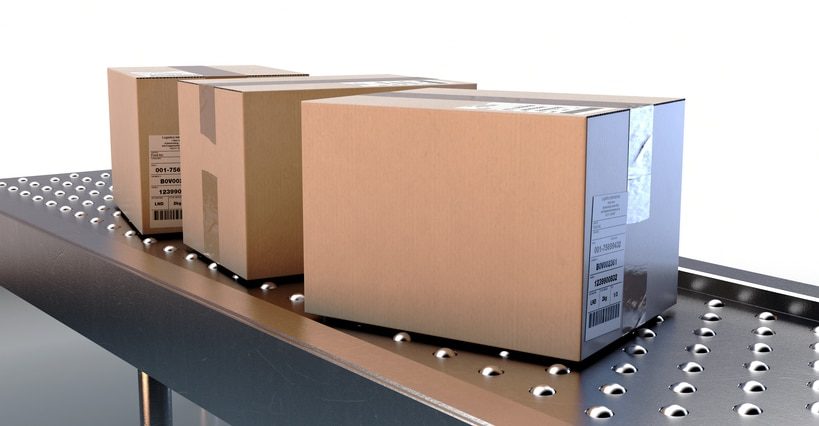
The individual balls on a ball transfer table are made of a “main ball” that’s usually between 1- and 1.5-inches. This main ball sits in a bowl of around 80 smaller “support balls” that serve as bearings. The system is sealed to keep out dust and other contaminants.
Magnetic conveyor
In the right conditions – namely, when moving ferrous loads – magnetic conveyors can achieve higher speeds and precisions than their non-magnetic counterparts.
This is due to their design. Ferrous loads are attracted to discrete magnets placed under the conveyor bed, which can either be a traditional belt conveyor or a stainless steel slider bed. The strength of the magnets prevents loads from slipping or changing direction even when moving vertically.
Magnet conveyors can be designed with magnetic fields of precise strengths, customized to handle particular loads. Facilities moving nuts and bolts will have different needs from those moving circuit boards or other computer components, which will have still-different needs from those moving large metal objects or needing to deal with metal shavings.
Magnetic fields are removed simply by returning the magnets under the conveyor bed in a continuous loop. The load – still sitting atop the conveyor bed – is unable to continue traveling with the magnet that had once held it. This leaves the load free to fall in a bin or move to a standard conveyor.
Bucket conveyor
Bucket conveyors are most often used to convey bulk materials such as grain, ore, sand, and chemicals. They consist of a series of buckets attached to an endless loop of chain or belt. When tipped, the buckets can automatically discharge their loads.
The wide variety of bucket conveyors on the market makes them a versatile material-handling option. They can be used to move loads both horizontally and vertically, can deliver their loads to a single point or to multiple points, and can handle delicate material such as cereals and chemicals.
Continuous bucket conveyors are called by some manufacturers a “belt and bucket” system. The buckets in these conveyors are attached directly to the belt. Material is poured into the buckets at an inlet, and is discharged as the belt rolls over the head drum.
A typically constructed pendulum bucket conveyor is a series of buckets suspended between two chains, which are wrapped around sprockets in a continuous loop. The buckets can be tipped at multiple points on their route, allowing for multiple drop offs. They can also be made to stay upright during their entire trek, without dropping their load.
Chute conveyor
Perhaps the best description of a chute conveyor is one that most of us will be familiar with from our childhood playgrounds – they are, to put it simply, slides.
With no moving parts and gravity as their power source, they are also one of the least expensive conveyors. They are used to convey loads between floors or between different moving conveyors, and to accumulate items in shipping.
They can be designed as straight slides, as slides with scoops, or as spirals, and can allow for multiple entry points.
Drag/chain/tow conveyors
Drag, chain, and tow conveyors come in many shapes and sizes, and can handle many different kinds of loads.
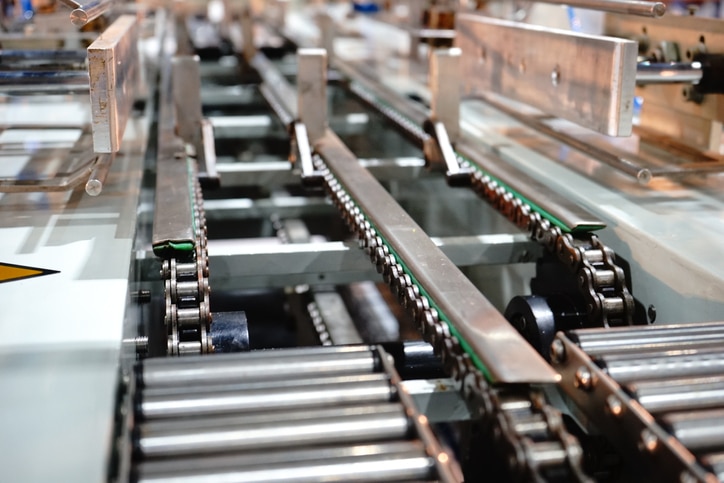
This has important ramifications for the kinds of loads that can be conveyed. While it would be possible, and sometimes beneficial, to design a chain conveyor for small, light loads, they are more often seen moving larger items such as trucks or carts. These are used to haul the load, which could be pallets, drums, variably-shaped items, or anything else that needs to be transported.
Largely due to their strength, but also to their versatility, drag chain conveyors are often seen in manufacturing applications. Anything from a series of engine blocks to entire vehicles can be dragged along the chain to different workstations.
Overhead conveyor
The main purpose of an overhead conveyor is to move loads above work stations. Loads are conveyed by a looping chain, from which they hang. Systems can be designed to follow any continuous path, and are able to change direction both horizontally and vertically.
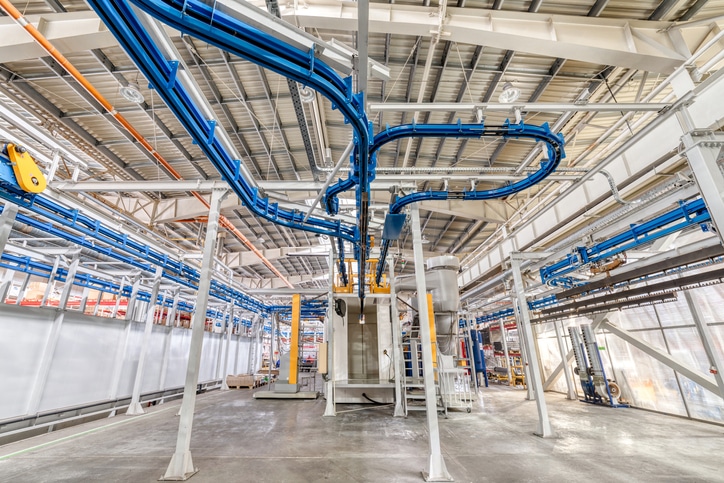
Overhead conveyors are an effective option for accumulation and storing. By their nature, they make use of overhead space, and can pack items closely together.
Power and Free conveyor systems give operators the ability to start and stop loads, adjust speeds, vary spacing, accumulate loads, and more. The design of these systems combines powered track with non-powered trolleys in a variety of ways.
Pneumatic/vacuum conveyors
Pneumatic and vacuum conveyors move bulk goods through pipes by creating pressure variances. Simply put, air made to flow through pipes – by the creation of pressure or vacuum, or a combination of the two – carries material along with it.
Vacuums are able to pull material from multiple origins to a single point. Pressure conveying, on the other hand, easily pushes material from a single origin to multiple destinations.
By design and necessity, these systems are closed, which creates a sanitary environment for the load, as well as a safer, dust-free environment for the facility.
Goods typically conveyed pneumatically include powders, pellets, flakes, resins, tablets, and feeds. Depending on the requirements of the design, systems can use flexible piping, which easily handles corners and bends and is perfect for retrofits and upgrades.
Screw/auger conveyors
You may remember learning about the auger conveyor – also known as an Archimedes’ Screw – in grade school. They consist of a helical blade mounted in a tube or trough. Rotating the blade allows liquid and semi-solid material to travel up the blade.
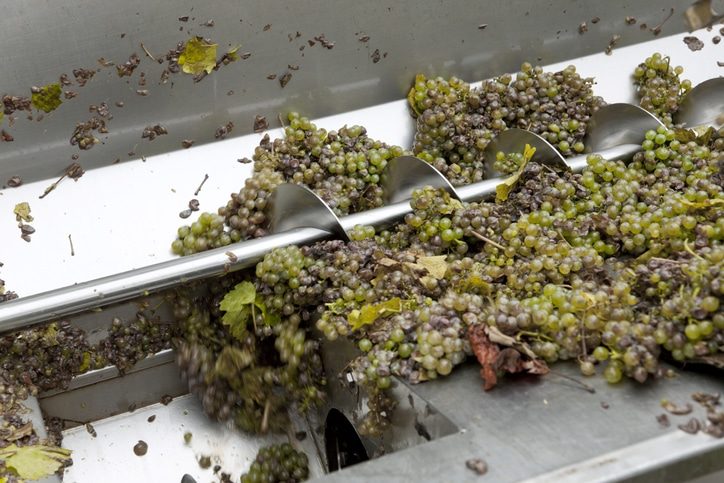
Aside from its efficiency, a key benefit of the auger conveyor is the ease with which it is able to control the flow of material. Simply increasing the rate of rotation of the blade increases the throughput of the load.
Vertical conveyor
Vertical conveyors are designed to raise and lower loads within the smallest possible footprint. While chutes, screws, and even belts can be designed to move product vertically, they all require horizontal space to do it in. A vertical conveyor’s footprint, in contrast, is more like an elevator shaft (though they don’t all work in the same manner as an elevator).
Continuous vertical conveyors, for example, may have a belt with collapsible shelves. Items moving down an infeed conveyor automatically move onto a shelf, which then travels vertically before automatically depositing the load. As the belt swings around for the return trip, the shelf collapses against it, allowing the system to have the smallest possible footprint.
Vertical indexing conveyors function much like continuous vertical conveyors. Product moving down an infeed conveyor is automatically deposited on a shelf and moved vertically. Indexing conveyors, however, don’t move continuously. Instead, they pause while their load is placed, allowing for more precise placement.
Vertical reciprocating conveyors, in contrast, act more like elevators in that their platform lowers and raises (reciprocates) along the same path. Because they are not designed to carry passengers, reciprocating conveyors are exempt from many of the regulations affecting elevators, and instead have their own ASME standard. They can be designed for loads as light as 10lbs, or as heavy as 100,000lbs.
Vibrating conveyor
A conveyor system may use vibration in one of two ways – either as a means of moving product down the line, or of packing product more closely.
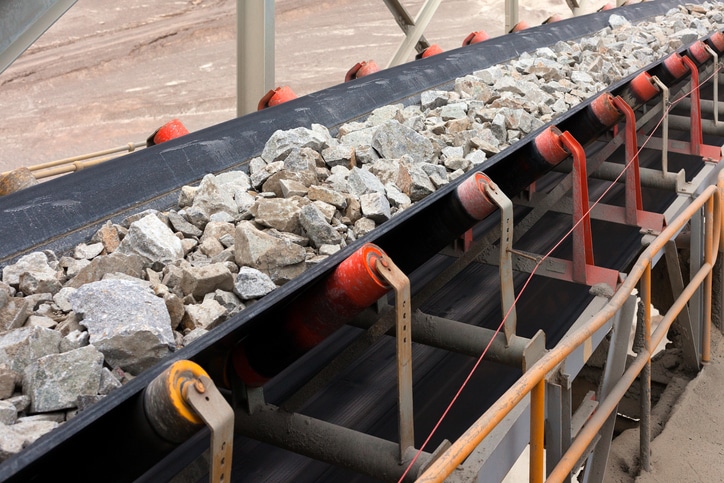
The rate of motion is determined by the frequency and amplitude of the sinusoidal wave.
While this process may sound violent, low frequencies and amplitude are in fact very gentle, and are even appropriate for friable goods.
Another use of vibration in material handling, sometimes also called a “vibrating conveyor,” is a conveyor that packs items tightly by causing them to settle in their container. Gentle vibration removes air pockets in bulk goods, which can reduce packaging, handling, and shipping costs.
Walking beam conveyor
A walking beam is an oscillating lever that pivots on a central axis. A walking beam conveyor consists of two basic parts – a support surface (which, perhaps confusingly, may look like a beam) and the walking beam. A motor drives the walking beam, which oscillates back and forth in a way that lifts, carries, and returns a load to the support surface.
The support surface is equipped with evenly spaced, fixed holders that temporarily receive loads as they are moved down the line. The precise movement and positioning of loads are an advantage, for example, in the food industry, where packages may be filled at multiple stations before being covered.
Wheel conveyor
Wheel conveyors – also known as skate-wheel conveyors, due to the appearance of their wheels – are composed of a series of wheels mounted on axles which are attached to frames.
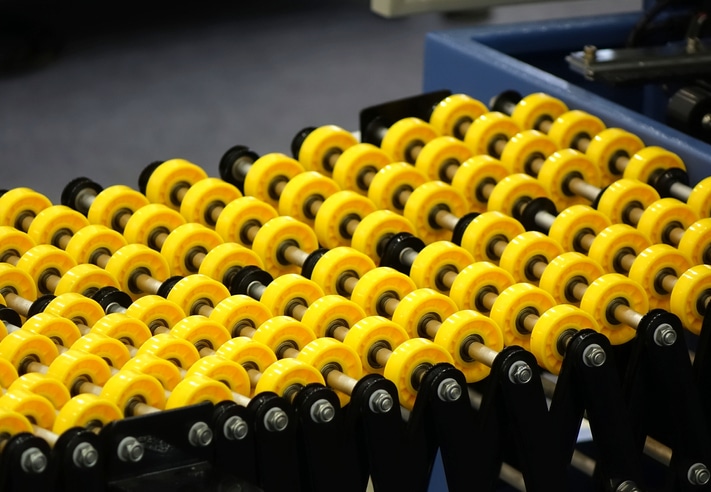
The size and weight of the expected loads determine the size and spacing of the wheels; a load should be supported by five or more wheels on three or more axles at all times.
A world of options just a phone call away
We hope this primer has given you some insight into some of the most common conveyors and how they can help you, as well as answered some of your questions. We know, however, that there are more kinds of conveyors than we could possibly list, and that conveyor systems are almost always hybrid creations of multiple types of conveyors working together.
If you want to learn more about conveyor systems and how they can help, contact us to talk details and strategies.
Increased efficiency of fulfillment with a custom gravity pallet flow conveying system
Custom gravity pallet flow conveying system for various weight and capacity requirements increased efficiency of fulfillment and reduced touch-points between receiving and manufacturing stations.

